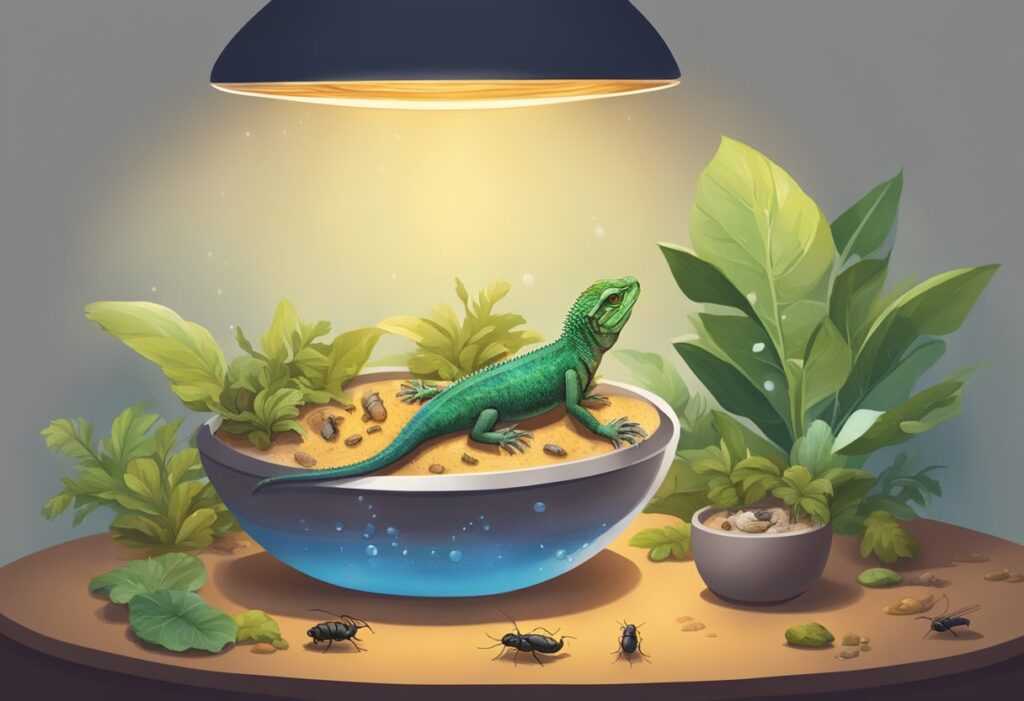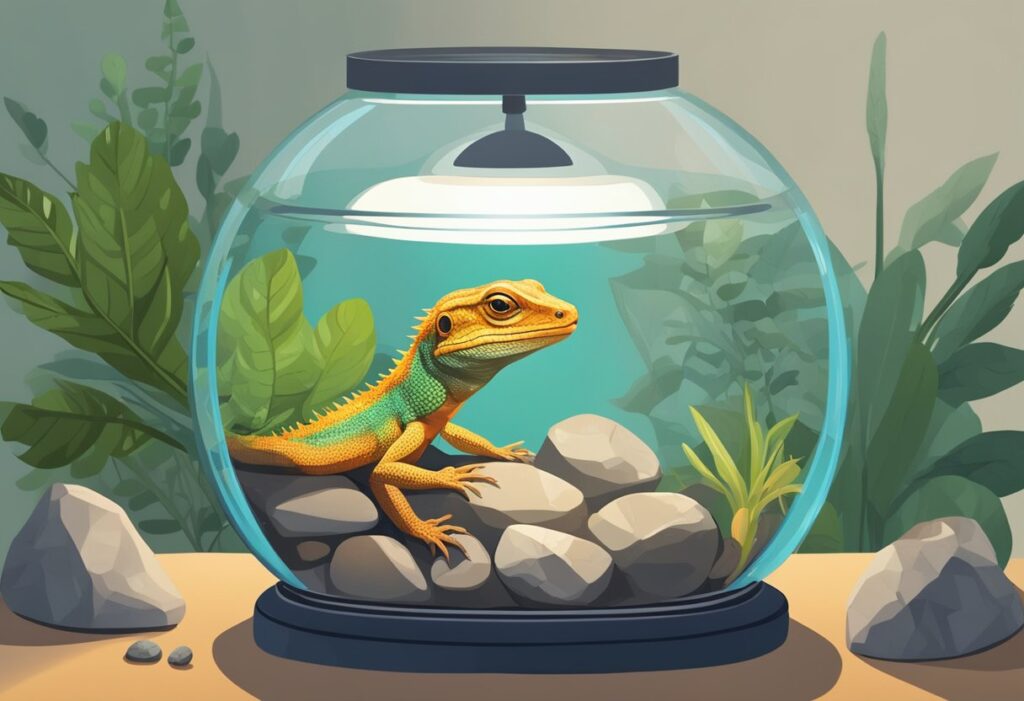Having a pet lizard can be a rewarding experience, offering a unique blend of joy and companionship. These remarkable creatures have their own set of needs and behaviors that can fascinate and delight their owners. They are not just pets but a long-term commitment, as some species can live for many years with proper care.

Before bringing a lizard into your home, it’s essential to understand that they require a specific environment to thrive. Their habitat needs to match their natural surroundings as closely as possible, including the right temperature, humidity, and space. Opting for a pet lizard means being prepared to invest in their well-being, by providing a suitable terrarium, the correct diet, and regular veterinary care.
Embracing the role of a lizard owner comes with its challenges, but the reward is observing the unique behaviors and forming a bond with a truly distinctive pet. They may not be the conventional choice for a companion animal, but for those willing to meet their needs, lizards can bring a sense of wonder and satisfaction to their human caretakers.
Choosing Your Lizard
When selecting a pet lizard, one should consider species-specific needs, ease of care, and compatibility with their lifestyle. The right lizard can bring years of joy, so it’s crucial to make an informed choice.
Species Overview
Different lizard species require various levels of care, habitat, and interaction. Bearded dragons and leopard geckos are known for being more docile, making them well-suited for human interaction. In contrast, species like the iguana can grow quite large and may require more specialized care and housing as they mature. When exploring lizard options, also consider the climate needs specific to the reptile, as some species have complex heating and lighting requirements.
Ideal Lizards for Beginners
For those new to reptile care, beginner-friendly lizards offer a good starting point. They usually have simpler care requirements and are more tolerant of handling.
-
Bearded Dragons: Often considered the ideal pet lizard for beginners due to their docile nature and manageable size. They require a warm environment and a varied diet, which includes both plants and insects.
-
Leopard Geckos: These small reptiles are nocturnal and known for being gentle. They don’t need as much vertical space, making their enclosures easier to manage. They typically eat insects and do not require complex lighting setups.
The anole, another lizard suitable for novices, is often praised for its vibrant colors and active daytime behaviors. Anoles can be a good choice for beginners looking to take a smaller step into the world of reptiles.
By understanding the unique aspects of these lizard species, potential owners can better prepare to provide the care that these fascinating creatures deserve.
-

Beaded Dragon Fan Exclusive: ‘Original Hipster’ T-Shirt – Wear Your Unique Style with Pride – Unisex t-shirt
£13.00 – £20.50 Select options This product has multiple variants. The options may be chosen on the product page -

Chinese Water Dragon Aquatic Mastery Tee: Dive into Elegance with Our Exclusive Reptile Enthusiast Shirt – Unisex t-shirt
£13.00 – £20.50 Select options This product has multiple variants. The options may be chosen on the product page
Setting Up the Habitat
Creating an ideal habitat is crucial for the health and well-being of a pet lizard. It involves more than just an enclosure; one must carefully consider the terrarium requirements, heating and lighting, and maintaining appropriate humidity and temperature levels.
Terrarium Requirements
The size and design of a terrarium are vital for lizards, as these spaces need to mimic their natural environment. For example, long-tailed lizards require a spacious terrarium to accommodate their active lifestyle and growth potential. It’s important to ensure the terrarium has enough room for the lizard to move around comfortably. The right substrate should be chosen to reflect the lizard’s natural habitat, providing them with a surface that supports digging and burrowing if needed.
Heating and Lighting
Reptiles are ectothermic, relying on external sources to regulate their body temperature. A basking spot with a heat source is essential, preferably one that can be easily controlled. UV light is also critical for most lizard species, as it helps them synthesize vitamin D3, which is important for calcium absorption. A combo fixture that provides both UV and heat can be a practical solution.
| Needs | Lighting Solution |
|---|---|
| Heat | Basking bulbs |
| UVB exposure | Fluorescent UVB tubes |
Maintaining Humidity and Temperature
Monitoring and adjusting the humidity and temperature within the habitat is non-negotiable for a pet lizard’s health. Owners should use a hygrometer to regularly check the humidity levels, aiming to keep them consistent with the species-specific requirements. Similarly, it’s important to maintain the correct temperature gradient within the terrarium; warm for basking and cooler areas for rest. Digital thermometers can ensure accurate readings and the health of the reptile.
Feeding and Nutrition
Proper nutrition is critical for a pet lizard’s health. They require a balanced diet that meets their specific species’ needs, from protein-rich insects to an array of vegetables and fruits.
Basic Diet Requirements
For reptile enthusiasts, understanding a lizard’s basic diet requirements is paramount. Lizards vary greatly in their dietary needs. Some are insectivorous, thriving on a diet primarily composed of insects like crickets and mealworms. Others may be omnivorous, needing both animal protein and plant-based foods. It’s crucial to know whether the lizard is a carnivore, herbivore, or omnivore.
Insectivorous Lizards: They rely heavily on insects. A list of common insects fed to lizards includes:
- Crickets
- Mealworms
- Waxworms
- Dubia roaches
Herbivorous Lizards:
- Vegetables: A variety of leafy greens and other veggies should constitute a large portion of their diet.
- Fruit: Should be offered sparingly due to high sugar content.
Omnivorous Lizards: They need a combination of:
- Insects
- Vegetables
- Occasionally, fruit
Supplementing with Vitamins
To ensure your lizard’s diet is nutritionally complete, supplementing with vitamins is often necessary. Calcium and vitamin D3 are particularly important for bone health, as many lizards are prone to metabolic bone disease without proper supplementation. A balanced supply of other vitamins and minerals is critical for preventing nutritional deficiencies.
Vitamin Supplements:
- Calcium powder without vitamin D3 for reptiles with proper UVB lighting.
- Calcium powder with vitamin D3 for reptiles without access to natural sunlight or adequate UVB lighting.
- Multivitamins formulated for reptiles should be used sparingly, as per the recommendations for the species.
Important Notes:
- Always consult a reptile veterinarian or a reliable care guide for the species-specific vitamin schedule.
- Over-supplementation can be just as harmful as a deficiency, so it’s crucial to find the right balance.
Health and Veterinary Care

When welcoming a pet lizard into one’s life, understanding the importance of health and veterinary care is crucial. This entails recognizing common health issues they might face and the necessity of regular check-ups with a qualified veterinarian to ensure their well-being.
Common Health Issues
Lizards can suffer from a variety of health problems, but metabolic bone disease (MBD) is one of the most prevalent. It’s linked to calcium deficiency and insufficient UV light. Symptoms may include weakness or deformed bones. Stress can also compromise their immune system, making them more vulnerable to diseases. In addition, they might experience complications with shedding if humidity levels are not optimal. Parasites, both internal and external, are another common concern that requires a vet’s attention.
Regular Health Check-Ups
Regular visits to a veterinarian who specializes in reptiles can prevent many health issues from becoming serious. They will perform routine check-ups to monitor your lizard’s overall health, screen for parasites, and guide you in providing the correct diet and environment. They can also offer advice on proper shedding care and how to minimize stress in your pet’s life. Establishing a relationship with a vet ensures that your lizard has access to expert care, should any health issues arise.
Interaction and Behavioral Care
Proper interaction and understanding of behavior are essential for the well-being of a pet lizard. They help foster a positive human-reptile relationship and minimize stress for these sensitive creatures.
Handling Your Lizard
When one decides to handle their pet lizard, it is crucial to do so with care and patience. Each lizard has its own temperament, and their willingness to be held can vary. To reduce stress for the pet, one should ensure their hands are warm and approach the lizard in a slow, non-threatening manner. One should also monitor their lizard’s body language closely during interactions to avoid causing distress.
Key Steps for Safe Handling:
- Wash Hands: Before and after to prevent the spread of germs.
- Support: Gently support their body from below.
- Frequency: Limit handling to short sessions, especially initially.
- Observation: Watch for signs of stress or discomfort.
Handling should always be done with respect to the pet’s comfort levels, and one should avoid grabbing or restraining the lizard forcibly, as this can lead to injury or mistrust.
Understanding Lizard Behavior
Recognizing and interpreting a lizard’s behavior can lead to a more harmonious existence with them. Lizards communicate primarily through their body language, displaying behaviors such as puffing up their body or changing color to indicate their mood. Through habitual observation, an owner can discern between a display of curiosity and a warning sign of aggression.
- Signs of Stress: Hiding, lack of appetite, or excessive panting.
- Content Behaviors: Exploratory movements or relaxed basking.
Understanding these cues helps one interact with their pet lizard in a way that respects the lizard’s personality and promotes positive experiences for both the pet and owner.
Long-term Care Considerations

Adopting a pet lizard involves more than a one-time setup; it requires a dedicated long-term plan to ensure the health and happiness of your scaly friend. This involves understanding the commitment required and providing an environment that simulates their natural habitat.
Commitment and Responsibilities
When one chooses to bring a pet lizard into their home, they’re making a significant long-term commitment. Many lizards have a lifespan ranging from a few years to several decades, depending on the species. Owners must be ready to provide consistent care and attention throughout the pet’s life. This includes daily feeding, maintaining an adequate supply of water, and regular cleaning of the cage.
| Aspect | Consideration |
|---|---|
| Lifespan | Can be up to 20 years, depending on the species. |
| Feeding | Must be consistent with dietary requirements. |
| Cage Maintenance | Regular cleaning is vital for the lizard’s wellbeing. |
Environmental Enrichment
Environmental enrichment is crucial for the wellbeing of pet reptiles. They require a habitat that allows for normal behaviors, which means providing enough space to move freely, decor to stimulate activity, and equipment for maintaining proper temperature and humidity levels.
- Space: The cage should be large enough for the lizard to exercise and explore, at least twice as long as the adult-size lizard.
- Decor: Rocks, branches, and foliage not only make the enclosure look more attractive but also provide necessary enrichment for the lizard’s mental and physical health.
- Equipment: Investing in quality heating, lighting, and humidifying systems is essential to replicate the lizard’s natural environment and support its health.
By understanding and addressing these long-term care considerations, owners can ensure that their pet lizards lead full, healthy lives.

